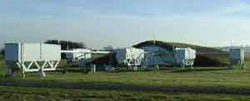This area deals with the fundamental laws and building blocks of nature and how they interact, the properties and the behavior of matter, and research into space and time and their structures.
innovations-report provides in-depth reports and articles on subjects such as astrophysics, laser technologies, nuclear, quantum, particle and solid-state physics, nanotechnologies, planetary research and findings (Mars, Venus) and developments related to the Hubble Telescope.

The basic technology that produces X-rays has remained essentially the same for a century, but now scientists and physicians at the University of North Carolina at Chapel Hill and Applied Nanotechnologies Inc. say they should be able to improve it significantly.
Experiments the team conducted have shown they can cause carbon nanotubes, a new form of carbon discovered about a decade ago, to generate intense electron beams that bombard a metal “target” to produce X-rays. Researchers say they

Ceramic materials with “split personalities” could lead to new high-temperature superconductors, according to physicists at Ohio State University and their colleagues.
Researchers here have learned that these ceramic materials, called cuprates (pronounced KOOP-rates), switch between two different kinds of superconductivity under certain circumstances.
The finding could settle a growing controversy among scientists and point the way to buckyball-like superconductivity in ceramics.

Surprise Discovery with World`s Leading Telescopes
Combining data from the NASA/ESA Hubble Space Telescope (HST) and the ESO Very Large Telescope (VLT), a group of European and American astronomers have made an unexpected, major discovery.
They have identified a huge number of “young” stellar clusters, only a few billion years old , inside an “old” elliptical galaxy (NGC 4365), probably aged some 12 billion years. For the first time, it has been possible to identify several

Scientists from the University of Cambridge’s Astrophysics Group have today (21 June 2002) announced a collaboration with teams based in New Mexico, Puerto Rico and at the Naval Research Laboratory in Washington DC to design, install and operate a novel type of astronomical telescope for ultra-high angular resolution observations of stars, galaxies and quasars.
The agreement between researchers based in the Astrophysics (AP) Group at the Cavendish Laboratory and the Magdalena Ridge Observato

Theoretical physicist Lennaert Huiszoon has described a new family of strings in research conducted at the National Institute for Nuclear Physics and High Energy Physics. He investigated so-called open strings which can describe elementary particles with a strong interaction.
With string theory, physicists are trying to construct a unifying theory for gravity and quantum mechanics. The theory describes extremely heavy and very small objects such as the universe shortly after the Big Bang or

Adaptive optics technology can remove the blurring effect of the Earth’s atmosphere that has long plagued astronomers, allowing ground-based telescopes to achieve a clarity of vision previously attainable only by space-based instruments. Current adaptive optics (AO) systems are able to make images that are superior to those of the Hubble Space Telescope in infrared light.
The technology still has limitations, however. For example, today’s adaptive optics systems on the largest tel